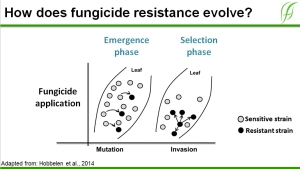Doutoranda: Maíra Rodrigues Duffeck. (19/06/2018 às 16:00 horas). Orientador: Emerson M. Del Ponte. Resumo: Fungicides, especially systemic ones, have definitely played a key role in the control of many important plant diseases. However, given their characteristics and improper management, populations of resistant strains have emerged and contributed to decreased efficacy of some of the active ingredients. Therefore, designing long-lasting and effective strategies to control plant disease remains a key challenge. Several tactics have been proposed to minimize the surge of fungicide resistance, including (i) adjust of fungicide dose, (ii) defining the number of sprays, (iii) mixing of fungicides (iv) alternating fungicides with different modes of actions and, (v) better timing applications. Ideally, the choice of strategy should be based on sound experimental and theoretical evidence. While field experiments are labor-intensive and time consuming, mathematical modeling provides the tools for testing hypotheses about strategies aimed to delay or reduce the selection in the pathogen population. Over the last decades, several models have been developed to inform decision-making under various situations and management scenarios. These models range from simple functions representing governing principles of resistance evolution to complex models for quantitative studies, incorporating large ranges of detailed knowledge of the system. Models that capture the large characteristics of the pathogen’s life-cycle and that can be used to predict its dynamics are therefore increasingly attractive to stakeholders and policy makers. Therefore, calibrated and statistically validated models can be used to simulate changes in the frequency of resistance and sensitive strains over seasons influenced by a range of management scenarios, and compare the efficacy of controls. Examples of the various approaches will be presented and discussed as well as the future challenges in modeling fungicide resistance.

